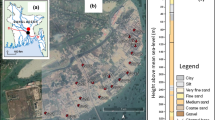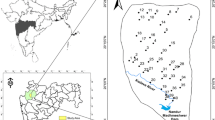Abstract
The present study was conducted to evaluate the metal pollution of groundwater in the vicinity of Tuticorin Corporation in Tamilnadu State, India, used by various pollution indices such as heavy metal pollution index (HPI), heavy metal evaluation index (HEI), and degree of contamination (DOC). Thirty-six groundwater samples were collected during the summer season (May 2013) and the concentration of metals Al, Cr, Fe, Cu, Mn, Ni, Zn, Cd, and Pb was analyzed. Consequences exhibited that groundwater was contaminated with Mn (59.12 ppb), Cu (162.41 ppb), Pb (196.15 ppb), Cr (187.12 ppb), and Cd (10.11 ppb). Correlation and factor analysis revealed that the sources of metals in groundwater in the study area are the same, and it may due to the leachates from the nearby sewage farm, industrial activity (State Industries Promotion Corporation of Tamil Nadu Limited (SIPCOT)), Buckle canal, and solid wastes dumped in the residential area. Groundwater pollution indices of HPI, HEI, and DOC revealed that most of groundwater samples belonged to the medium to high zones, which was adjacent to the polluted Buckle canal, SIPCOT industrial waste, and sewage fish farm in the coastal area. The present study points out that the metal pollution causes the degradation of groundwater quality around Tuticorin coastal corporation. These study results will be very helpful for sustainable management of groundwater resources, and they will enable planners and policymakers to evolve a strategy to solve similar problems elsewhere.






Similar content being viewed by others
References
Agarwal E, Rajat A, Garg RD, Garg PK (2013) Delineation of groundwater potential zone: an AHP/ANP approach. J Earth Syst Sci 122(3):887–898
Akinbile CO, Yusoff MS (2011) Environmental impact of leachate pollution on groundwater supplies in Akure, Nigeria. Int J Environ Sci Dev 2:81–86
Antony Ravindran A, Selvam S (2014) Coastal disaster damage and neotectonic subsidence study using 2D ERI technique in Dhanushkodi, Rameshwaram Island, Tamilnadu, India. Middle East J Sci Res 19(8):1117–1122
APHA (1995) Standard methods for the examination of water and wastewater, 19th edn. American Public Health Association, New York
Backman B, Bodis D, Lahermo P, Rapant S, Tarvainen T (1997) Application of a groundwater contamination index in Finland and Slovakia. Environ Geol 36:55–64
Balaram V (1993) Characterization of trace elements in environmental samples by ICP-MS. At Spectrosc 6:174–179
Balasubramanaian AR, Thirugnana S, Chellaswamy R, Radhakrishnan V (1993) Numerical modeling for prediction and control of saltwater encroachment in the coastal aquifers of Tuticorin, UGC publisher, Tamil Nadu. Tech Report, p 21
Bhuiyan MAH, Parvez L, Islam MA, Dampare SB, Suzuki S (2010) Heavy metal pollution of coal mine affected agricultural soils in the northern part of Bangladesh. J Hazard Mater 173:384–392
Caboi R, Cidu R, Fanfani L, Lattanzi P, Zuddas P (1999) Environmental mineralogy and geochemistry of the abandoned Pb–Zn Montevecchio-Ingurtosu mining district, Sardinia, Italy. Chron Rech Min 534:21–28
Chidambaram S, Prasanna MV, Vasu K, Shahul Hameed A, UnnikrishnaWarrier C, Srinivasamoorthy K (2007a) Study on the stable isotope signatures in groundwater of Gadilam river basin, Tamilnadu, India. Indian J Geochem 22(2):209–221
Chidambaram S, Ramanathan AL, Prasanna MV, Anandhan P, Srinivasamoorthy K, Vasudevan S (2007b) Identification of hydrogeo chemically active regimes in groundwater of Erode district, Tamilnadu-a statistical approach. Asian J Water Environ Pollut 5(3):93–102
Cole M, Hood L, McDermott R (1984) Ecological invalidity as an axiom of experimental cognitive psychology. Harvard University Press, Cambridge, In press
Edet AE, Offiong OE (2002) Evaluation of water quality pollution indices for heavy metal contamination monitoring. A study case from Akpabuyo-Odukpani area, Lower Cross River Basin (southeastern Nigeria). Geol J 57:295–304
Farmaki EG, Thomaidis NS (2008) Current status of the metal pollution of the environment of Greece – a review. Glob NEST J 10:366–375
Forstner UK, Wittman GTW (1981) Metal pollution in the aquatic environment. Springer Verlag, Berlin, p 255
Fosmire GJ (1990) Zinc toxicity. Am J Clin Nutr 51(2):225–227
Horton RK (1965) An index system for rating water quality. J Water Pollut Control Fed 37:300–306
Howitt D, Cramer D (2005) Introduction to SPSS in psychology: with supplement for releases 10, 11, 12 and 13. Pearson, Harlow
Hutton M, Symon C (1986) The quantities of cadmium, lead, mercury and arsenic entering the U.K. environment from human activities. Sci Total Environ 57:129–150
Kasprzak KS, Sunderman FW, Salnikow K (2003) Nickel carcinogenesis. Mutat Res 533:67–97
Koterba MT, Wilde FD, Laphan WW (1995) Groundwater data collection protocols and procedures for the national water quality assessment program collection and documentation of water quality samples and related data. US Geological Survey Open file report 95–399. USGS, Virginia, p 113
Magesh NS, Chandrasekar N (2012) Evaluation of spatial variations in groundwater quality by WQI and GIS technique: a case study of Virudunagar District, Tamil Nadu, India. Arab J Geosci. doi:10.1007/s12517-011-0496-z
Magesh NS, Chandrasekar N, Vetha Roy D (2011) Spatial analysis of trace element contamination in sediments of Tamiraparani estuary, southeast coast of India. Estuar Coast Shelf Sci 92(4):618–628
Mohan SV, Nithila P, Reddy SJ (1996) Estimation of heavy metal in drinking water and development of heavy metal pollution index. J Environ Sci Health 31:283–289
Mondal NC, Singh VP, Singh VS, Saxena VK (2010) Determining the interaction between groundwater and saline water through groundwater major ions chemistry. J Hydrol 388(1–2):100–111
Nolan K (2003) Copper toxicity syndrome. J Orthomol Med 12(4):270–282
Nriagu JO, Pacyna JM (1988) Quantitative assessment of worldwide contamination of air, water and soils by trace-metals. Nature 333:134–139
Prasad B, Bose JM (2001) Evaluation of the heavy metal pollution index for surface and spring water near a limestone mining area of the lower Himalayas. Environ Geol 41:183–188
Prasanna MV, Praveena SM, Chidambaram S, Nagarajan R, Elayaraja A (2012) Evaluation of water quality pollution indices for heavy metal contamination monitoring: a case study from Curtin Lake, Miri City, East Malaysia. Environ Earth Sci 67:1987–2001
Reddy SJ (1995) Encyclopaedia of environmental pollution and control, vol. 1. Environmental Media, Karlia
Selvam S (2012) Use of remote sensing and GIS techniques for land use and land cover mapping of Tuticorin Coast, Tamilnadu. Univ J Environ Res Technol 2(4):233–241
Selvam S (2014) Irrigational feasibility of groundwater and evaluation of hydrochemistry facies in the SIPCOT Industrial Area, South Tamilnadu, India: a GIS approach. Water Qual Expo Health. doi:10.1007/s12403-014-0146-2
Selvam S (2015) A preliminary investigation of lithogenic and anthropogenic influence over fluoride ion chemistry in the groundwater of the southern coastal city, Tamilnadu, India. Environ Monit Assess 187:106. doi:10.1007/s10661-015-4326-8
Selvam S, Iruthaya Jeba Dhana Mala R, Muthukakshmi V (2013a) A hydrochemical analysis and evaluation of groundwater quality index in Thoothukudi district, Tamilnadu, South India. Int J Adv Eng Appl 2(3):25–37
Selvam S, Manimaran G, Sivasubramanian P (2013b) Hydrochemical characteristics and GIS-based assessment of groundwater quality in the coastal aquifers of Tuticorin corporation, Tamilnadu, India. Appl Water Sci 3:145–159
Selvam S, Manimaran G, Sivasubramanian P (2013c) Cumulative effects of septic system disposal and evolution of nitrate contamination impact on coastal groundwater in Tuticorin, South Tamilnadu, India. Res J Pharm Biol Chem Sci 4(4):1207–1218
Selvam S, Manimaran G, Sivasubramanian P, Balasubramanian N, Seshunarayana T (2014a) GIS-based evaluation of water quality index of groundwater resources around Tuticorin coastal city, South India. Environ Earth Sci 71:2847–2867
Selvam S, Antony Ravindaran A, Rajamanickam M, Sridharan M (2014b) Microbial contamination in the sediments and groundwater of Tuticorin Corporation, South India using GIS. Int J Pharm Pharm Sci 6(4):337–340
Selvam S, Manimaran G, Sivasubramanian P, Seshunarayana T (2014c) Geoenvironmental resource assessment using remote sensing and GIS: a case study from southern coastal region. Res J Recent Sci 3(1):108–115
Selvam S, Magesh NS, Chidambaram S, Rajamanickam M, Sashikkumar MC (2014d) A GIS based identification of groundwater recharge potential zones using RS and IF technique: a case study in Ottapidaram taluk, Tuticorin district, Tamil Nadu. Environ Earth Sci. doi:10.1007/s12665-014-3664-0
Selvam S, Magesh NS, Sivasubramanian P, Prince Soundranayagam J, Manimaran G, Seshunarayana T (2014e) Deciphering of groundwater potential zones in Tuticorin, Tamil Nadu, using remote sensing and GIS techniques. J Geol Soc India 84:597–608
Siegel FR (2002) Environmental geochemistry of potentially toxic metals. Springer, Berlin
Singaraja C, Chidambaram S, Prasanna MV, Paramaguru P, Johnsonbabug TC, Thilagavathi R (2012a) A study on the behavior of the dissolved oxygen in the shallow coastal wells of Cuddalore District, Tamilnadu, India. Water Qual Expo Health 4:1–16. doi:10.1007/s12403-011-0058-3
Singaraja C, Chidambaram S, Anandhan P, Prasann MV, Thivya C, Thilagavathi R (2012b) A study on the status of fluoride ion in groundwater of coastal hard rock aquifers of south India. Arab J Geosci. doi:10.1007/s12517-012-0675-6
Singaraja C, Chidambaram S, Srinivasamoorthy K, Anandhan P, Selvam S (2015) A study on assessment of credible sources of heavy metal pollution vulnerability in groundwater of Thoothukudi districts, Tamilnadu, India. Water Qual Expo Health. doi:10.1007/s12403-015-0162-x
Srinivasamoorthy K, Chidambaram S, Prasanna MV (2008) Identification of major sources controlling groundwater chemistry from a hard rock terrain: a case study from Mettur taluk, Salem district, Tamilnadu, India. J Earth Syst Sci 117(1):49–58
Srinivasamoorthy K, Nanthakumar C, Vasanthavigar M, Vijayaragavan K, Rajiv Ganthi R, Chidambaram S (2011) Groundwater quality assessment from a hard rock terrain, Salem district of Tamilnadu, India. Arab J Geosci 4:91–102. doi:10.1007/s12517-009-0076-7
Tariq SR, Shaheen N, Khalique A, Sha MH (2010) Distribution, correlation, and source apportionment of selected metals in tannery effluents, related soils, and groundwater - a case studies from Multan, Pakistan. Environ Monit Assess 166:303–312
Tariq MM, Eyduran E, Bajwa MA, Wahed A, Iqbal F, Javed Y (2012) Prediction of body weight from testicular and morphological characteristics in indigenous Mengalishep of Pakistan: using factor analysis scores in multiple linear regression analysis. Int J Agric Biol 14:590–594
Venkatramanan S, Ramkumar T, Anithamary I (2012) A statistical approach on hydrogeochemistry of groundwater in Muthupet coastal region, Tamin Nadu, India. Carpathian J Earth Environ Sci 7:47–54
Venkatramanan S, Chung SY, Ramkumar T, Gnanachandrasamy G, Vasudevan S (2013) A multivariate statistical approach on physicochemical characteristics of groundwater in and around Nagapatttinam district, Cauvery deltaic region of Tamil Nadu, India. Earth Sci Res J 17:97–103
Venkatramanan S, Chung SY, Kim TH, Prasanna MV, Hamm SY (2014) Assessment and distribution of metals contamination in groundwater: a case study of Busan city, Korea. Water Qual Expo Health. doi:10.1007/s12403-014-0142-6
Young RA (2005) Toxicity profiles: toxicity summary for cadmium, Risk Assessment Information System, RAIS, University of Tennessee. http://rais.ornl.gov/tox/profiles/cadmium.shtml. Accessed 8 Oct 2014
Acknowledgments
The first author S. Selvam is thankful to the Department of Science and Technology, Government of India, New Delhi, for awarding INSPIRE Fellowship to carry out this study (Ref. No. DST/INSPIRE FELLOWSHIP/2010/ (308), date: 3 August 2010). The authors are also grateful to Shri A.P.C.V. Chockalingam, Secretary and Dr. C. Veerabahu, Principal, V.O.C College, Tuticorin, for their support to carry out the study.
Author information
Authors and Affiliations
Corresponding author
Rights and permissions
About this article
Cite this article
Selvam, S., Venkatramanan, S. & Singaraja, C. A GIS-based assessment of water quality pollution indices for heavy metal contamination in Tuticorin Corporation, Tamilnadu, India. Arab J Geosci 8, 10611–10623 (2015). https://doi.org/10.1007/s12517-015-1968-3
Received:
Accepted:
Published:
Issue Date:
DOI: https://doi.org/10.1007/s12517-015-1968-3




